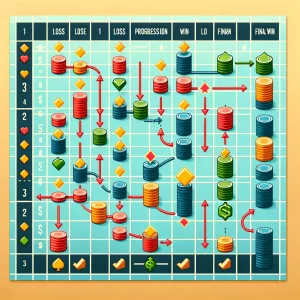🃏🎲🎰Try It At BetFury Casino🎰🎲🃏
The Martingale Strategy is one of the oldest and most discussed betting strategies in the realm of casino gambling. Rooted in simplicity, its core principle involves doubling your bet after every loss, with the aim of recouping past losses and gaining a profit equal to the original bet upon your first win. This strategy is often applied in games with close to a 50/50 chance, such as betting on red or black in roulette.
Originating in 18th-century France, the Martingale was first popularized within the gambling salons. The strategy is designed for bets with even odds, and its simplicity makes it accessible to both novice and experienced bettors. Despite its straightforward approach, it’s crucial to understand its mechanics, potential risks, and the importance of having a substantial bankroll.
Mechanics of the Martingale:
- Starting Bet: Begin with a small base bet, e.g., $1 on a red/black bet in roulette.
- After a Loss: If you lose, double the bet for the next round ($2).
- After a Win: Once you win, revert to the original bet size ($1).
- Cycle Repeat: Continue this cycle after every loss, doubling the bet, and returning to the base bet after a win.

Theoretical Example:
- Starting with a $1 bet and experiencing a loss streak of 4 rounds, your bets would progress as $1, $2, $4, $8, and then a win at $16, recovering all losses plus an additional $1.
Risks and Considerations:
- Bankroll Limitations: The exponential growth of bets can quickly deplete your bankroll.
- Table Limits: Casinos often impose table limits that can halt the Martingale progression.
- Long-Term Viability: The strategy is risky over the long term, as the potential for a prolonged losing streak can lead to significant financial loss.
Coin-Flip Simulation:
Let’s consider a simpler scenario with a coin flip, where you bet on heads with the same starting bet of $1.
- Flip 1: You bet $1 on heads. It lands on tails. You lose.
- Flip 2: Doubling your bet, you wager $2 on heads. It lands on tails again. You lose.
- Flip 3: You double down once more, betting $4 on heads. This time, it lands on heads. You win.
Outcome: Your losses from the first two flips amount to $1 + $2 = $3. Your win from the third flip is $4. Subtracting your total losses from your win leaves you with a net profit of $1, mirroring your initial bet.
Roulette Scenario:
Imagine you’re at a roulette table, and you decide to bet on black with a starting bet of $1.
- Round 1: You bet $1 on black. The ball lands on red. You lose.
- Round 2: Following the Martingale Strategy, you double your bet to $2 and place it on black again. The ball lands on red again. You lose.
- Round 3: You double your bet to $4 on black. This time, the ball lands on black. You win.
Outcome: In the first two rounds, you lost $1 + $2 = $3. In the third round, you won $4. Your net profit is $4 (win) – $3 (losses) = $1, which is equal to your initial bet.
Analysis:
Both scenarios demonstrate the fundamental principle of the Martingale Strategy—recovering from losses by doubling the bet after each loss, with the goal of achieving a profit equal to the initial bet upon securing the first win. These examples highlight the strategy’s potential for short-term gains but also underscore the risks associated with rapid bet escalation, especially during a prolonged losing streak. It’s crucial to approach this strategy with caution, considering the limits of your bankroll and the table limits imposed by casinos.
Engage with the Martingale strategy in Your Next BetFury Casino Visit, but remember to set limits and gamble responsibly. Share your experiences and thoughts in the comments below.
The Martingale Strategy offers a straightforward approach to potentially recover losses. However, its effectiveness is subject to the constraints of bankroll size and table limits. As with any betting strategy, it’s essential to practice responsible gambling and consider the risks involved.
Authored by the BetFury Ninja, a dedicated analyst and enthusiast of casino strategies. For more insights and detailed strategy breakdowns, follow our blog and join our community.










